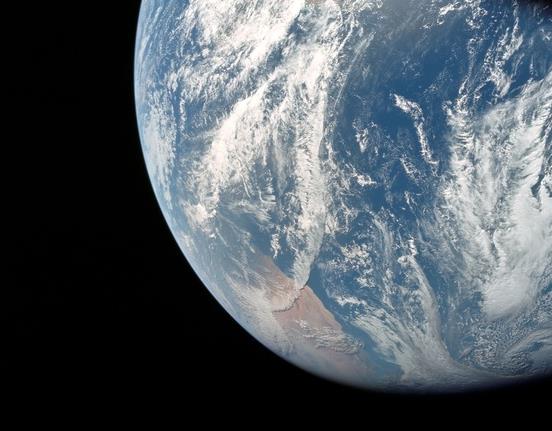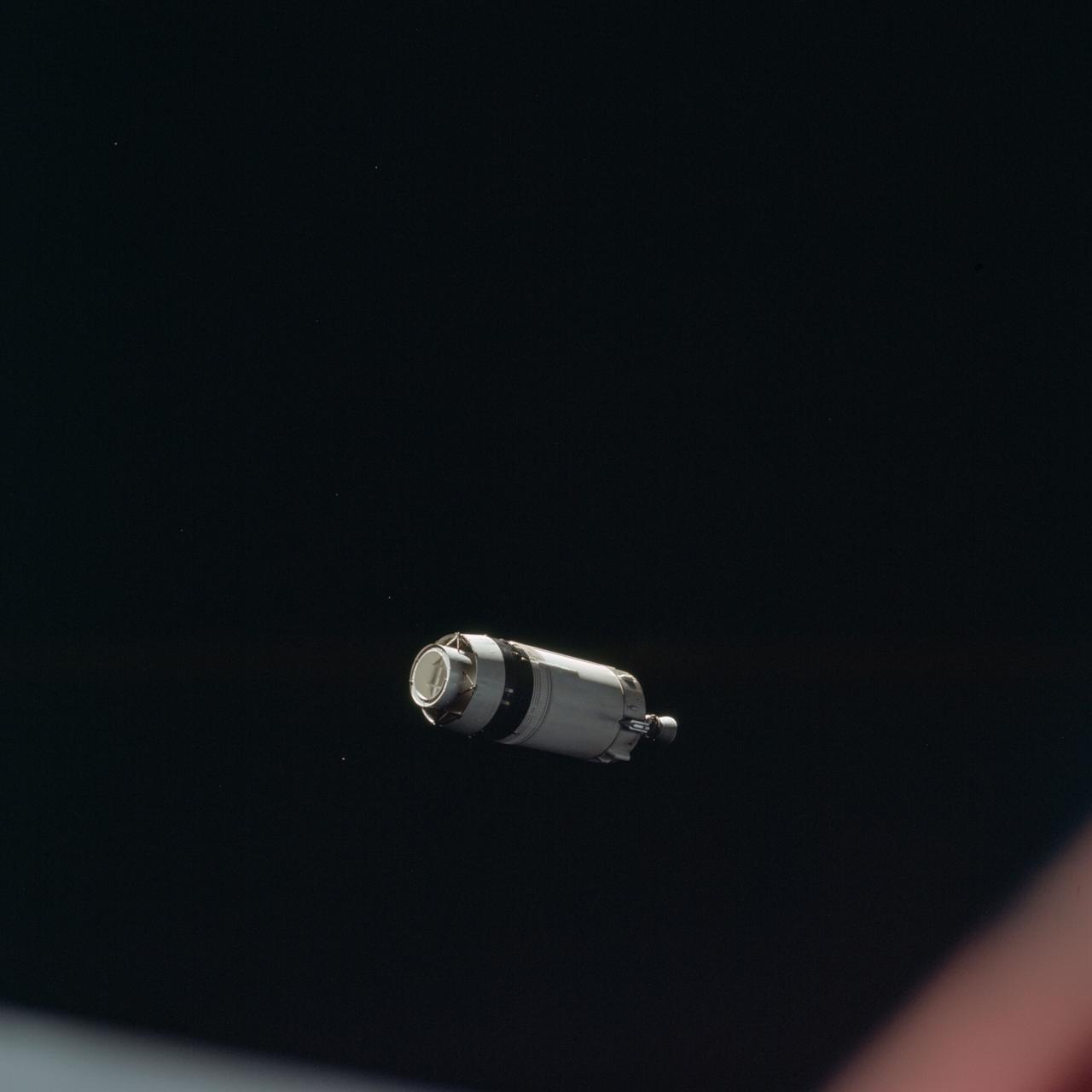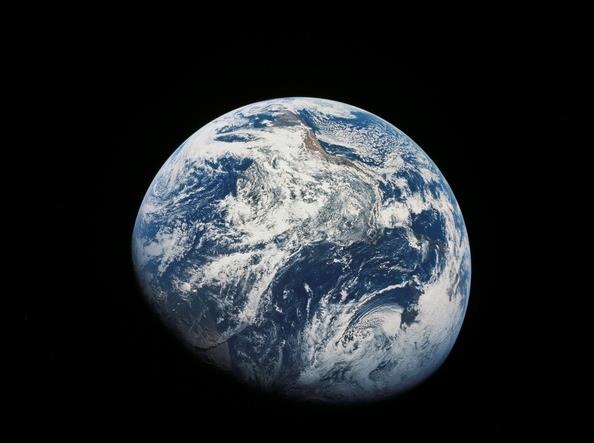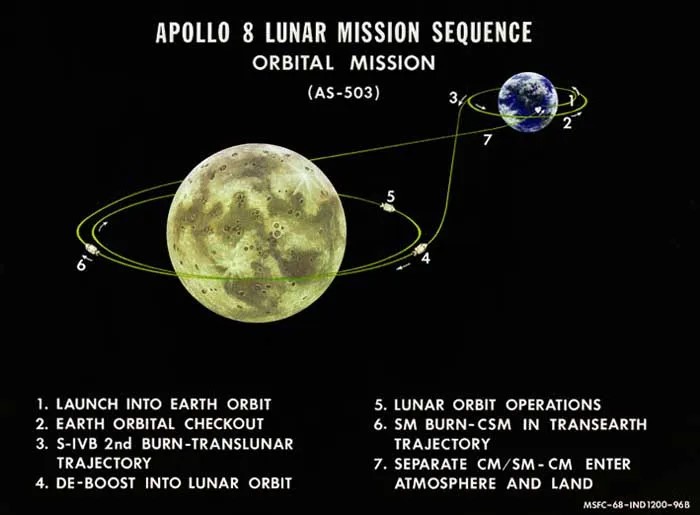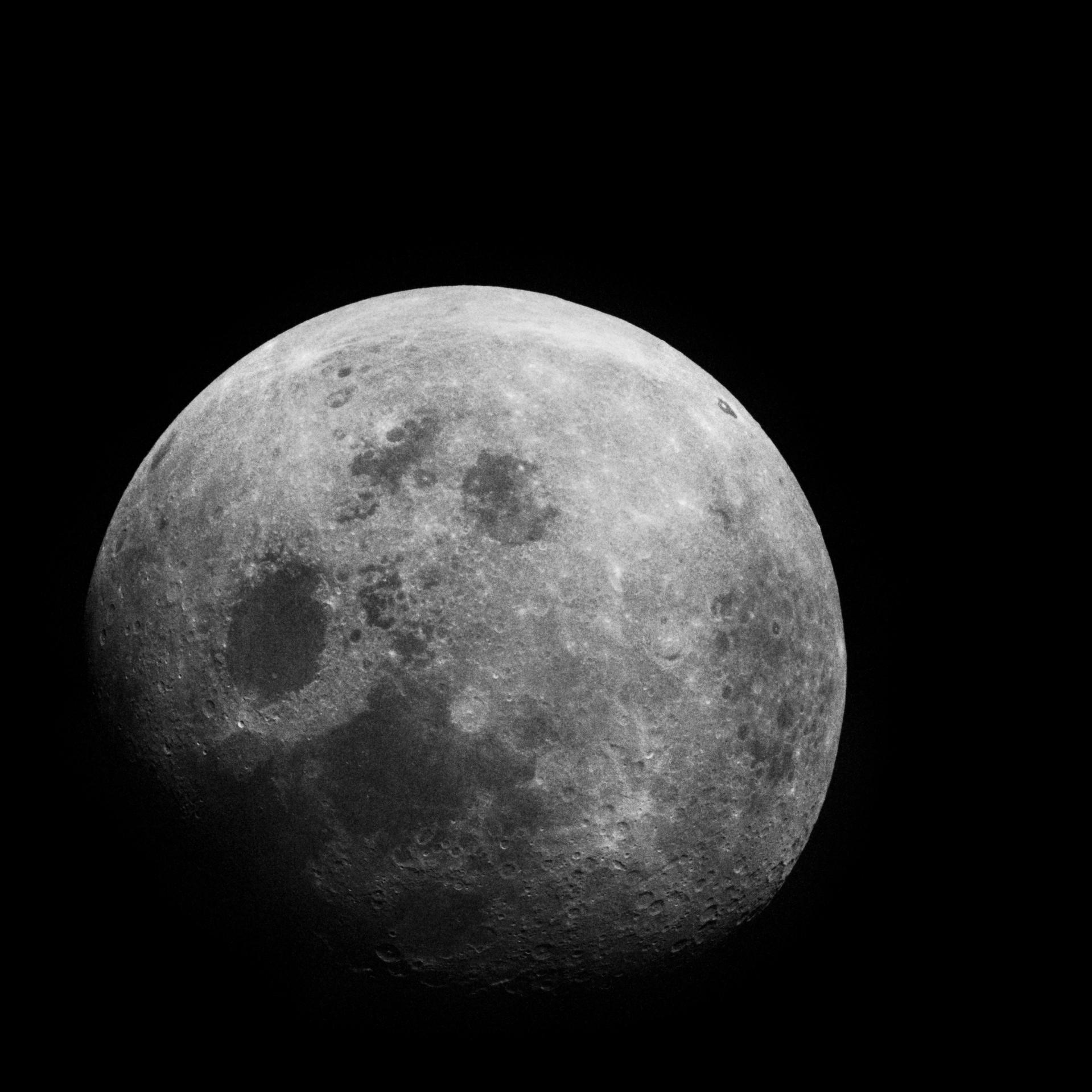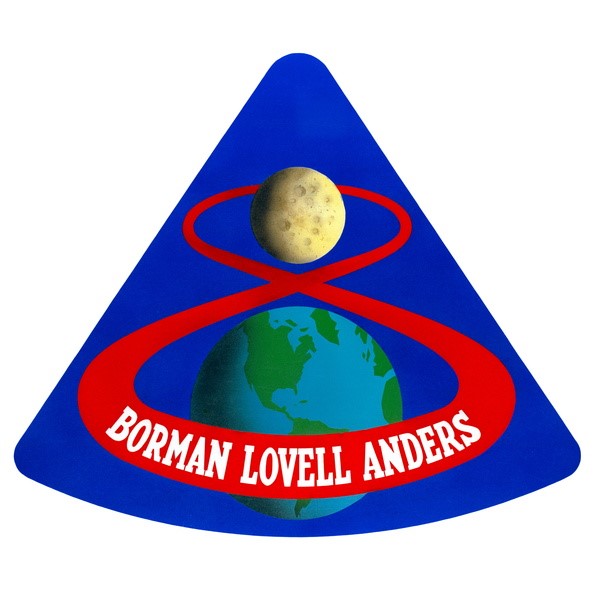Astro Info Service Limited
Information Research Publications Presentations
on the Human Exploration of Space
Established 1982
Incorporation 2003
Company No.4865911
E & OE
Apollo 8 Part 2
APOLLO 8 MISSION REPORT
Part Two - From the Earth to the Moon
In the first part of this in-depth report of the first human journey to the Moon, we recalled the origins of the mission and launch of the first crewed flight of the Saturn V rocket on 21 December 1968. In this second instalment, we look at the flight from Earth to the Moon, covering the period 21 to 24 December 1968.
Leaving the Blue Planet Behind
For 5 minutes and 18 seconds, the single J-2 engine at the back of the S-IVB stage pushed the astronauts into their couches once more. The engine carried Apollo 8 out of Earth orbit and further into deep space until they reached almost 39,000 kph (24,226 mph), or 10,830 m/sec (35,523 fps). This time when the engine cut off and the astronauts floated forwards in their harnesses, they would remain in the zero-g state inside the Command Module (CM) for the next six days.
Controllers at Mission Control back in Houston who were monitoring the performance of the Trans-Lunar Injection (TLI) burn confirmed that Apollo 8 was well on its way to the Moon. The astronauts knew it too, but not by the view out of the window. There wasn't one, nor was there a sensation of speed. Instead, the numbers displayed on the computers in front of them were telling them what they needed to know. THe next task was to separate the Command and Service Module (CSM) from the now-spent Saturn third stage, allowing the spacecraft to continue its journey alone. Firing both the explosive bolts and the small Reaction Control System (RCS) thrusters on the sides of the Service Module (SM), the spacecraft separated from the top of the third stage with a bone-shaking jolt, some 3 hours 21 minutes into the mission. As it did so, the Spacecraft Lunar Adapter (SLA) panels were jettisoned and the high-gain communication antenna deployed at the back of the SM. At 152 m (500 ft) separation, the CSM was turned around to point back at the stage and the crew kept station for about ten minutes looking at the large stage and the countless 'stars' of ice particles following it. The sight was overshadowed by their view of the full blue and white Earth behind it.
This was the first time that humans had seen Earth as a whole planet. Though only a few hours into the mission and less than an hour after leaving Earth orbit, the view was spectacular to the three astronauts as the globe of Earth filled the entire window. Words and pictures could not convey the majesty of seeing our little blue and white planet with their own eyes, with the greens and browns of the land masses and the curvature of the Earth evident against the jet black of space.
That image would stay with all who followed the three Apollo 8 astronauts. This was also one of the images that helped to stimulate the global movement for environmental concerns and a perspective from space of life on Earth, a 'benefit' from Apollo that is often overlooked.
Jim Lovell found it hard to interpret what he was seeing: "Boy, it's really hard to describe what this Earth looks like. I'm looking out of my centre window, the round window [in the side hatch] and the window is bigger than the Earth right now. I can see most of South America all the way up to Central America, Yucatan and the peninsula of Florida." For Bill Anders, it was amazing how delicate and beautiful the Earth looked before him. Frank Borman had a more profound thought: "This must be what God sees," he wrote years later. Looking at almost the whole Western hemisphere in one view, the three astronauts each gathered their thoughts as they watched it all shrink away before their eyes. Their first sight of Earth out of their window had only been ten minutes before and in that 600 seconds they had moved a further 5,633 km (3,500 miles) deeper into space.
Distracted by the sight of Earth, the crew continued station-keeping and photographing the spent stage and the planet. The photos revealed the Lunar Test Article (LTA-B) hardward used to provide Lunar Module (LM) launch mass for the mission. The manoeuvre by Borman to turn the CSM around was part of the so-called Transposition and Docking Manoeuvre. On lunar landing missions, the CSM would be separated and turned 180 degrees to return to the LM stored on top of the S-IVB, dock with it and extract it. On Apollo 7 in October 1968, this manoeuvre had been practiced in Earth orbit and the crew reported that the open panels of the SLA might cause a hindrance on missions carrying the LM, suggesting that they be jettisoned. This was performed for the first time on Apollo 8.
A brief firing of the RCS was performed to separate the stage and the spacecraft, but it was soon realised that the separation distance was insufficient and a second burn was initiated. The plan was to place the S-IVB stage into a solar orbit via the Moon. To accomplish this, a 'slingshot' manoeuvre (comprising a continuous Liquid Hydrogen (LH2) venting through a vent valve, a Liquid Oxygen (LOX) dump through the J-2 engine for five minutes and an ullage burn of the stage's auxilliary propulsion system for 12 minutes 44 seconds) increased the velocity of the stage and shifted the trajectory for it to fly past the trailing edge of the Moon at 1,263 km (682 nautical miles, nm) about 70 hours into the mission. The resulting orbits around the Sun would each last 340.8 days.
With the last stage of their booster on its way, the crew settled down to three days of coasting until they reached the vicinity of the Moon on 24 December. Those three days would cover about 376,586 km (234,000 miles). The accuracy of the TLI burn was such that it should have only needed one mid-course correction to refine the trajectory and ensure the correct insertion into lunar orbit, planned at 120 km (65 nm). However, as a result of the two small manoeuvres to separate from the S-IVB, a second mid-course burn would be needed. The first was completed about 11 hours into the mission, with the 2.4-second burn of the Service Propulsion System (SPS) resulting in a reduction in apogee at the Moon from 848.4 km (458.1 nm) down to 123.1 km (66.5 nm). The second burn would occur closer to the Moon.
"Feeling Like a Wet Floor Mop"
During their first space mission together in December 1965, Frank Borman and Jim Lovell had experienced 14 days of weightlessness aboard Gemini 7. Lovell had returned to space for four days aboard Gemini 12 with Buzz Aldrin in November 1966. Now, during this mission to the Moon, the two were joined by Bill Anders on a six-day mission, but in a spacecraft larger than Gemini. This allowed them to leave their couches, take off their pressure suits and (by folding the centre couch) tumble around in mid-air. Gemini 7 had been likened to living in the front seats of a small family car for a fortnight. Apollo 8 was larger, but with three of them it was still a cramped place to spend a week.
The additional room to manoeuvre meant that the crew could start to move about early in the mission. This caused all three astronauts to suffer the symptoms of what is now termed Space Adaptation Syndrome (SAS), or the adjustment of the body to the state of weightlessness. This is similar to mild sea-sickness, resulting in fullness of the head and, in the case of rapid body movement (especially the head), feelings of nausea. These feelings lasted for the first 24 hours of the mission but did not affect the operational objectives of the flight. Frank Borman suffered the most, experiencing a bout of headaches, vomiting and diarrhoea after a rest period. This was initially thought to be due in part to exposure to a viral epidemic noted in the Cape area just prior to the mission. Borman also reported side effects from a sleeping tablet he had taken that were the same as when tested for the drug during pre-mission training.
During Borman's illness, Lovell and Anders tried to keep conversation and movement around the spacecraft down to a minimum, but Borman found it difficult to keep anything down. After further rest, the symptoms passed and he felt much better. He later recalled in his 1988 autobiography how strange it was that his two missions were so different: "Unhappily, I remembered spending two weeks in Gemini 7 and never getting sick. Apollo 8 was only 14 hours into its mission and here was the commander feeling like a wet floor mop," he wrote.
Off to the Moon
Finding position and direction in the void of space is a combination of star sightings, computers, gyros and information fed up from Earth. Large objects (the Sun, Moon, Earth and other spacecraft) can be used as reference sources and data to be fed into the computer, giving angles to allow the crew to point the spacecraft in the direction they wish to go. Elapsed time measurements and engine burns to increase or decrease velocity give translation along the given path to get them where they ought to be.
Leaving the S-IVB behind meant locating the Earth in the window to get the required angle for navigation to ignite the engines. Borman juggled the controls of the spacecraft for over ten minutes to locate the Earth. When asked by Mission Control if the separation burn had been accomplished, Borman said it would be "as soon as we find the Earth". This caused amusement down in Mission Control, who thought it strange that something as large as the Earth was difficult to find.
Jim Lovell was the main navigator on the mission and his 'duty station' was down in the Lower Equipment Bay, essentially under the three couches, where he could use a combination of the spacecraft's navigational computer and a sextant to sight several known stars and the Earth's horizon to provide angle measurements manually, in case communications with Earth were lost. Recording the elapsed time of the mission, their velocity and these angles, the crew could determine exactly where the spacecraft was in space. But there were problems with this system. Water or urine dumps overboard crystallised in the cold, creating thousands of new 'stars', or ice crystals, that floated with the spacecraft as they progressed along their journey to the Moon and seriously hampered star sightings. However, these methods and the measurements from the gimbals in the Inertial Measurement Unit (IMU) gave a navigational sighting as accurate as possible out to the Moon and later on the return home.
To keep the spacecraft's internal and surface temperatures even during the flight, the so-called 'Bar-b-que' roll was initiated, which meant firing the side RCS thrusters to place the vehicle in a slow roll, completing one revolution in every hour.
During the journey to the Moon, two TV casts were broadcast back to Earth. The first occurred on 22 December some 225,308 km (140,000 miles) out from Earth, with Anders holding the TV camera and Borman narrating as Lovell gave Earthbound viewers a glimpse of life inside a Moon-bound spacecraft. The grainy black-and-white images added to the spectacle seen across the globe of astronauts at work on the way to the Moon for the first time. Lovell demonstrated preparing a food package and sent it flying across the cabin. The position of the spacecraft meant they could not reveal the view out of the window, but Borman then took over the camera and turned it on Anders, who demonstrated a spinning toothbrush and wondered what all this looked like to people back on Earth. Borman relayed to the audience that, "This transmission is coming to you [from] approximately halfway between the Earth and the Moon." He apologised for not being able to show the Earth out of the window. Back on Earth, the British-based 'Flat Earth Society' and others deemed the mission a hoax, saying it was all done in a studio and that the Earth could not be shown because it was flat after all!
The problem was that, apart from floating astronauts and equipment, there was nothing much more to show. How could they convey that they were travelling further than anyone before them and faster than anyone had before? With no sensation of motion, it was hard for the astronauts themselves to realise just how far they were going and how fast. Lovell narrated next and took the view of an interplanetary traveller looking at the planet for the first time: "What I keep imagining is, if I were a traveller from another planet, what would I think about Earth at this altitude? Whether I would think it was inhabited..." Capsule Communicator (Capcom) Mike Collins, whom Lovell had replaced on the mission, replied: "Don't see anybody waving, is that what you are saying?" Lovell answered: "I was just kind of curious if I would land on the blue part or the brown part..." Collins observed: "You better hope we land [the CM] on the blue part..." The TV transmission ended with Lovell wishing his mother a happy birthday.
The next day (23 December), Anders was surprised that there was little to do with everything working perfectly and felt that the flight was different to what he had expected. It was not boring, far from it, just a little... empty. The crew were taking great care of the spacecraft's systems and the vehicle was taking care of them. With no LM there was little to do except float around and wait. The next transmission of TV pictures later that day offered the first chance to show the Earth out of the window. Unfortunately, the black-and-white image was fuzzy and needed added interpretation by the crew to help pick out the view and the spectacular colours they were seeing for the viewer. Just after ending the 25-minute TV broadcast, Apollo 8 passed into the location in space where the pull of the Moon's gravity surpassed that of Earth. This point, at 55 hours 38 minutes into the flight, occurred at 326,415 km (176,250 nm) from Earth and 62,597 km (33,800 nm) from the Moon. Up to this point, the spacecraft had gradually been slowing to 994 m/sec (3,261 fps), but as the influence of lunar gravity came into play, they slowly began to increase speed again.
"Go for LOI"
As midnight passed on Earth and it became Christmas Eve, Apollo 8 headed towards the Moon at 8,047 kph (5,000 mph). The crew turned their spacecraft around to face the large SPS engine opposite to the direction of flight in order to slow them down enough to be captured by the gravitational pull of the Moon and enter lunar orbit. Checking of the spacecraft by the crew was verified back on Earth by the team of flight controllers, making sure everything was fine to proceed. Too long a burn would mean they would slow too much and could crash on the far side of the Moon. Too short a burn would mean they would merely slip behind the Moon and begin a long flight back home without entering orbit. Borman was amazed that the controllers could tell more about his spacecraft from over 321,868 km (200,000 miles) away than he could from inside it.
The focus of this effort was the global Manned Space Flight Network (MSFN) of 14 land stations, four instrumented ocean-going tracking ships and eight instrumented aircraft, as well as land-based and Comsat communications systems. The land stations (with 9 m (30 ft) antennae dishes) could handle communications close to Earth, but for lunar distance the two 26 m (85 ft) dishes in Madrid, Spain and Canberra, Australia were used, along with the giant 64 m (210 ft) dish in Goldstone, California, to provide almost constant round-the-clock communication with Apollo 8 as the world turned on its axis.
About three hours into Christmas Eve, Capcom Jerry Carr radioed up the words: "You are Go for LOI [Lunar Orbit Insertion]. You're riding the best bird we can find." Strapped into their couches, the crew awaited the final moments of a three-day trip. They would fire their engine ahead of the leading edge of the Moon and (hopefully) enter a 111-km-high (69-mile) orbit, hoping that some undiscovered 112.5-km-high (70-mile) lunar mountain was not waiting for them. At Ground Elapsed Time (GET, or mission duration) 68:57:04, Carr informed the crew that there was one minute to Loss Of Signal (LOS). Then, 50 seconds later, he said: "Ten seconds to LOS... you're GO all the way." Anders responded with thanks to the teams on the ground, while Lovell replied: "We'll see you on the other side." At GET 68:58:04, Apollo 8 slipped behind the Moon and out of communications.
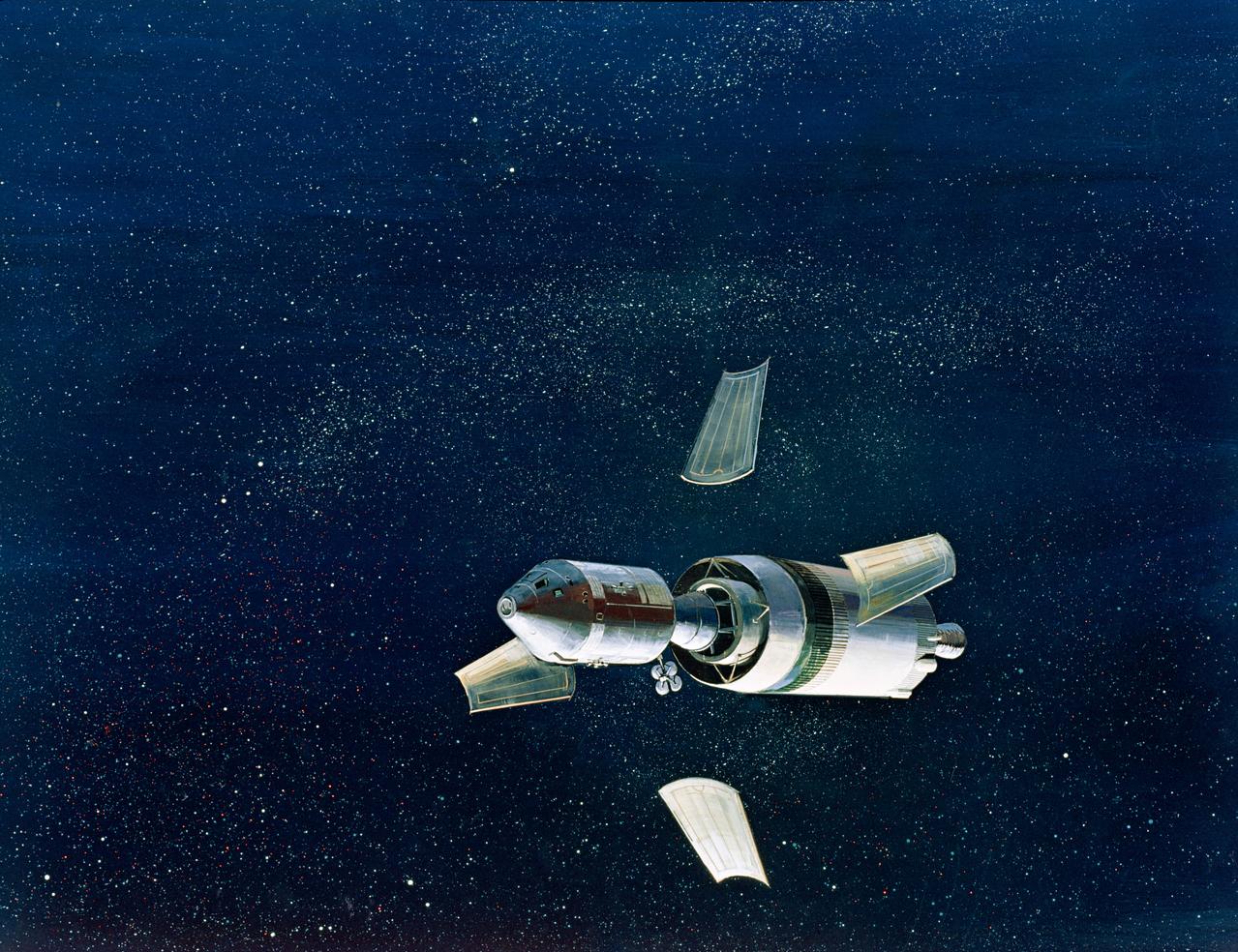
This North American Rockwell artist's concept illlustration shows a phase of the Apollo 8 mission in which the Spacecraft Lunar Module Adapter (SLA) panels that supported the CSM are jettisoned to enable the spacecraft to separate from the rocket stage.
Image courtesy of North American Rockwell and NASA.
For the first time on Apollo 8, human eyes were able to look back on our planet from a greater distance and view the Earth hanging in the blackness of space. This image was taken after the TLI manoeuvre and more spectacular views of the Earth would come later in the mission.
This image was taken from the Apollo 8 spacecraft looking back at the Saturn V third stage following separation after the TLI manoeuvre. Attached to the S-IVB is the Lunar Module Test Article (LTA) which simulated the mass of the LM on this mission. Sunlight reflections show the artificial 'stars' of the cloud of ice particles following the stage.
Speeding away from Earth, the astronauts were able to see the planet as a whole for the first time, rather than the proportional view from Earth orbit as on every previous mission. Images such as this were a significant boost for conservation movements back home.
Command Module Pilot (CMP) Jim Lovell is seen at the Apollo 8 spacecraft Command Module's Guidance and Navigation station during the mission. This image was taken from 16mm motion picture film.
Illustration showing the flight path and operational stages of the Apollo 8 mission, if all went well.
The target. After a three-day journey from Earth, the Apollo 8 crew were getting ready for the all-important Lunar Orbit Insertion (LOI) burn which, if successful, would see them become the first humans to orbit the Moon. And just in time for Christmas 1968.
This Mission Report is copyright Astro Info Service Limited 2003, 2025.
All images are courtesy of NASA, unless otherwise stated.




